
Back when bouldering first came onto the scene people just used beer towels. Skip ahead a few years and you've got the early foam mattresses, which - looking back on it - were like postage stamps compared to modern day offerings. Since then pads have got larger and larger, to the extent that super-large pads are now an independent category. Bigger mats mean more space to land on, which - in turn - means a safer place to fall; however, with great size comes great weight, not to mention an increase in bulk. These aren't pads for everyone, but for those who are willing to embrace the drawbacks the benefits in use are significant.
In order to maintain consistency we're decided to stick to the same set of criteria as we used in our mid-size bouldering mat group test, which are:
Foam: A larger pad doesn't just mean bigger in size, it also means more foam; however, each pad differs in terms of how this foam is layered. Soft layers help to absorb the force, whereas firmer layers help to spread it out across a wider area. Some of the pads reviewed use two layers, which are only suitable for use one way up; others use three layers, usable either way around (and these tend to have a more supportive feel). Irrespective of its construction the foam should be capable of taking repeated impact over time without softening.
Due to the sheer size of the biggest pads, they have the potential to be very uncomfortable in transit, so the carrying system is of absolute importance. Does it sit high or low on the back? Does it feature a hip belt and sternum straps? All of these are key factors, the lack of which could make even the shortest walk-in unpleasant.
Closing System: Some pads use zips, others use buckles, and some feature velcro straps - they're all different. Some are constructed using an easy-to-use and intuitive design, whereas others are remarkably complex, but perhaps more secure as a result. At the end of the day it's often a balance in between speed of closure and overall security. Another factor to take into consideration is whether the pad features a hinge, or whether it's a folding/'taco' design. The former is more compact, but means there's a potential point of weakness in the middle of the pad where the two halves meet; the latter doesn't have this issue, but is bulkier as a result, however it also provides space in the middle in which you can put all your other gear.
Durability: Here we'll cover not just the foam, but also the other fabrics and materials used throughout, including the various straps, buckles and fastenings. Given the hard use each pad is likely to get over its lifetime you want to know that the componentry is going to last as long as the rest. Taco pads deserve a special mention at this point, as they are technically meant to be stored open, as keeping them folded leads to the foam perishing in/around the folding point. This isn't always practical and - at least in our experience - doesn't appear to be a huge issue, but is worth being aware of.
Weight: A very obvious drawback of increasing a pad's size is that you increase its overall weight, with most of these rather beefy units coming in at between the 8-9kg mark. Generally speaking, the bigger the pad, the more it weighs; however, the bigger the pad the greater the size - hence it all comes down to what you're looking for (and if it's light weight you're after you probably want to look elsewhere!)
Other features: Some pads include an in-built door mat for you to clean your feet on, others have a small square of carpet sewn in. Each of these features will be covered in turn…
|
Make and model |
Pros and cons | |
|
Price: £380 Weight: 8.6kg Dimensions: 117 x 147cm Depth: 13cm |
Pros: Simple, bombproof, and reliable Cons: Price-wise it's at the upper end of the spectrum and due to its simplicity it could also be described as quite basic |
|
|
Price: £275 Weight: 8kg Dimensions: 160 x 120cm Depth: 14cm |
Pros: Good size and depth, great set of features, all at a highly competitive price Cons: The foam would benefit from being a little firmer, with softening particularly noticable in/around the crease |
|
|
Price: £390 Weight: 10kg Dimensions: 150 x 120cm Depth: 15cm |
Pros: This huge pad has a whopping 15cm depth, plus shock absorbing air cell technology, making it one of the best for highballing Cons: Due to its size it is also the heaviest - and the most expensive - pad on test |
|
|
Price: £360 Weight: 9.4kg Dimensions: 148 x 118cm Depth: 12.5 cm |
Pros: Undoubtedly the most comfortable carrying system on test, plus the best for putting your pack (safely) inside Cons: Can feel a bit faffy when moving between problems, plus it comes at a premium price |
|
|
Price: £229.99 Weight: 9kg Dimensions: 127 x 160cm Depth: 15cm |
Pros: Absolutely huge, both in terms of size and depth. Also (perhaps surprisingly) the cheapest on test Cons: Carrying system isn't great, plus the buckles drive our reviewer mad. The foam hinging is far from ideal too. |
|
|
Price: £265 Weight: 8kg Dimensions: 200 x110cm Depth: 10cm |
Pros: Due to its triple-folding nature it is ideal for stuffing into awkward cracks/placements, plus it has a huge surface area Cons: Not the thickest pad on test, plus it's quite unwieldy to carry and close. |
|
|
Price: £350 Weight: 8.5kg Dimensions: 120x178cm Depth: 10cm |
Pros: Large surface area to fall on, but folds up remarkably narrow - good for getting through gates and woodland Cons: Not the thickest - or cheapest - pad on test |
Organic Big Pad - £380
In the past few years, Organic has become something of an industry leader, certainly in reputation. They are renowned for making pads that last ages and the Big Pad is no exception. The focus on using very high quality foam, tough materials and bombproof stitching is a welcome break from other pads which all too often try to over complicate features. It's not the biggest pad in the review, but it's still pretty sizable - we'd certainly be reluctant to carry anything bigger on long walk-ins. Plus, anything larger and you'll have to start thinking about changing vehicle.
Foam
Sturdy is the first word that comes to mind when describing the Organic Big Pad and this is due to its unusual construction. The core features closed cell rubber, surrounded by outer layers of memory foam. From experience, if a pad is firmer initially it tends to fare better in the long run (if it starts out soft, it's going to become even softer - and therefore useless - pretty quickly). This Big Pad certainly feels firm, even slightly too firm initially, but this is well worth the trade off for longevity.
The pad's dimensions are 117cm x 147cm, 13cm thick when open and 26cm when closed. It's worth considering the size of your car before committing to this pad, and indeed any other in this review, as there's no point buying a big pad if you can't fit it in your boot. The thickness and rigidity of the foam mean that it isn't practical to carry a bag inside the pad – there simply isn't room and we're not convinced this is good for pads in general, putting unnecessary strain on the foam and closing system.
Carrying System and Comfort
The carrying system is at the simpler end of the spectrum in this group test. The pad has both a chest strap and a waist strap, which are both essential when carrying a pad of this size and weight. The shoulder straps are nicely padded, and the chest strap is highly adjustable, but the waist strap is slightly basic and can become uncomfortable on a long walk-in.
The positioning of the pad on your back can be changed. There is a simple velcro system which gives you two options of where to position the straps. This is essential for pads of this size because where the pad sits on your back will vary dramatically depending on your height.
Were there to be a drawback it is that there is no way to prevent it from getting extremely wet and muddy when putting it down in soggy ground. In the US, where the pad was designed, this was unlikely to be an issue; in the UK, this is something that climbers contend with on an almost daily basis.
Closing System
Bombproof buckles and stitching have always been a feature on Organic pads and the Big Pad is no exception. A pet hate of ours is when buckles and their adjusting mechanism are too fiddly to change with cold hands. Fortunately the Big Pad's buckles are about as easy as they come; furthermore, once they are strapped tight there is no way they are coming off.
Durability
The 1000 denier fabric in the landing area and 1050 denier on the shell mean that the Big Pad is built to last. Coupled with the bombproof stitching that was mentioned earlier, we've never had an integral part of the Big Pad fail (unlike many other pads where buckles and straps start to show their age). There is a simple handle on the side for dragging it around, which - like all other features on the the pad - is a no-frills affair, but it does exactly what it was designed for.
As previously mentioned, the foam is extremely firm when new, similar to how new matting at climbing wall feels; however, it's designed to last and we would expect a pad of this quality to keep going for upwards of five years. At £380 it's at the upper end of the prices in this group test, but given its durability it justifies the expense. However the price point may put it out of reach for some people.
Weight
At 8.6kg, the Big Pad isn't the heaviest in the test, but it's still heavy, and careful pad selection is needed for long walk-ins.
Other features
Organic have stuck with their winning formula and focused on the most essential parts of the pad: foam, carrying system and durability. The only other striking feature is the colour design, making it one of the most recognisable pads on the market. It manages to take over most photos it's featured in (although more subtle colours are available).
On their website, Organic state that all of the 1000d Cordura nylon comes from recycled cutting room floor scraps. Were there to be a drawback of this material it is that it is quite slippery on slopey ground, which can be a hazard, as the shift is noticeable - especially with other pads that have coatings to stop this from happening.
- For more info see Organic Big Pad
Moon Saturn - £275
In our Mid Size Bouldering Mat Group Test the Moon Warrior came out as Best in Test, offering a fantastic set of features for an affordable price. The Saturn is similarly strong, insofar as it super-sizes the same features - namely the ability to keep the back system clean and carry stuff inside it - and it does so for the highly competitive price of £275 (roughly £100 cheaper than some of the other mats on test). All-in-all it is a pad that is hard to fault, because it does everything you need to, but does so without getting overly complicated. As a result it was enthusiastically voted Best in Test by our review team.

Foam
The Moon Saturn has a 160 x 120cm landing area, with 14cm thick foam (to put this into context, that's pretty darn chunky). Landing on it feels secure and the size of the landing area is reassuring. The rectangular shape of the Saturn is basic compared to some of the triple-folding pads in this test, but it's exactly what you want for your main pad: simple and effective.
The Saturn uses a two-layer construction, with a single sheet of 30mm closed cell foam (the firmer stuff) on top of a single sheet of 110mm open cell foam (the softer, impact absorbing stuff) on the bottom. Overall it feels softer than some of the pads on test, which is quite suprising given the depth. During use we definitely noticed it getting softer too, particularly around the fold, which is perhaps a gentle reminder to store it unfolded (if you can).
Carrying System and Comfort
The padded shoulder straps and the waist strap on the Saturn are brilliant. In fact, they're so secure and hold the pad so well on your back that despite its 8kg it's comfortable and doesn't feel heavy when it's on your back.
The wrap-around panel which holds the pad together has the added benefit of allowing you to cover the back system whilst climbing, which has the twofold advantage of stopping the straps from getting dirty and also preventing them from becoming trip hazards.
Closing System
The closing system on the Saturn, like the other Moon pads, is simple but effective. On the top it has three metal buckles which close the pad securely. Three is - curiously - the magic number, as it allows you to simply close the middle one whilst doing 'short haul' transport from one problem to the next. If you only have two you have to do both up, which can be quite annoying and unnecessarily time consuming.
When the pad is closed the ingenious cover flap covers the base, giving a nearly complete coverage on the bottom side of the pad. This means you can happily shove a bag in the large cavity. There is a small space on the bottom side of the pad between the crease and where the flap begins so thin items - like a brush stick - can fall out, so be careful.
Durability
The durability of the Moon pad's outer materials is excellent: the buckles are hardwearing aluminum, the handles are solidly constructed and the outer shell is 600D ripstop polyester (strong stuff).
The durability of the Moon foam is up for debate. Our reviewer has been using the Saturn for over six months now and has noticed no decrease in the quality of the foam. However, given that you expect a pad of this size, quality and price to last you for years, that is admittedly not long enough to give a proper appraisal of the foam's durability. Looking at feedback such as this forum thread, it seems that climbers have different experiences of the longevity of Moon foam: some pads have lasted a long time, others have gone soft after a few years... perhaps there was just one bad batch of foam?
As per the intro, taco pads should technically be stored open, which is something worth bearing in mind as storing it closed can have an adverse effect on the pad's durability. Clearly this isn't always ideal, particularly with pads as large as this, as you need a similarly large space to store them which isn't always possible.
Weight
At 8kg the Saturn is a reasonable weight for its size. It's a big pad, and with that you expect a bit of heft, but it's nothing out of the ordinary.
Other features
The base of the Saturn has rough black anti-slip strips. These do what it says on the tin and stop your pad from slipping, both whilst standing and falling on it. Given that the majority of UK landings are slippery - often grass or mud - and that a totally flat landing is rare, the anti-slip strips are extremely useful and work remarkably well. There are fewer things more disconcerting than landing on your mat and having it slip out from underneath your feet, so this feature is one that we really love - not least because of its simplicity (you wouldn't notice it was there).
The Saturn also has an ingenious cover flap (mentioned earlier) which works in three different ways: firstly, it covers the bottom of the mat when folded so your belongings don't fall out. Secondly, when the mat is deployed it covers the straps so that you don't trip on them when walking or landing on the pad. Thirdly, when it's covering the straps, it's carpeted so that you can keep your shoes clean for optimal performance when climbing and to prevent unnecessary erosion on the rock. Another simple but effective feature.
- For more info see Moon Saturn
SNAP Grand Wham - £390
The heaviest and most expensive pad in the test, the SNAP Grand Wham is a bit of a beast. However, with a new improved carry system, sturdy components and some nice features, it is an investment piece that is built to last and a great 'one mat' if you're out by yourself. As well as being reassuringly thick, its Air Cell technology provides soft landings from shorter distances and firmer support for highball falls - you won't bottom out. This construction also means it is unlikely to go soft over time and its taco form is useful for padding out uneven landings. But all this comes at a hefty price and because of its construction, thickness and different landing feel, it doesn't always play nicely with other mats.

Foam
The Grand Wham uses SNAP's Air Cell Technology with twenty compartmentalised foam cells. Two types of foam are used: on the top is a full layer of 20mm high density impact-reducing EVA foam; beneath this each individually wrapped cell contains 120mm of high density impact absorbing polyurethane foam with a few holes in to release air. This means that the pad definitely has a right way up! The aim of the air cells is to stop air escaping too quickly and prevent rebound, giving a soft landing from a short distance and a firmer more supportive one from higher up. The thinner denser layer complements this really well by dispersing force across the surface. This definitely makes it a reassuring pad for highballing. For those who suffer from historical lower limb injuries, it is also more forgiving on joints than a traditional foam construction. We've also found that a crowd working a problem is always really pleased when you turn up and add a SNAP to the mix!
Carrying System and Comfort
With fully detachable shoulder straps and a lightly padded hip belt, SNAP have vastly improved the carrying system used in the previous larger air cell mats - formerly known as the 'Grand Wrap'. The addition of a hip belt makes a huge difference, giving the stability that is needed for such a bulky and heavy pad. All parts can be removed to declutter your landing, and the shoulder strap stashes in a fabric slot in the side of the mat.
Tested on a few people, we found that this system keeps weight on the hips with a reasonable centre of gravity, though being so large there is some weight higher up. If you have a shorter back or are just generally smaller, this is likely to feel unwieldy.
All in all, it's not the most comfortable of carries, but it's hard to think how something of this size and shape could actually be comfortable… if your approach is more than 30 minutes you might want to foist the carrying onto someone else!
Closing System
The Grand Wham closes intuitively with three strong velcro straps which thread through lightweight, robust buckles; two along the short edge and one on the bottom carrying edge. This avoids the fiddliness of buckles in the winter. However, the firmness of the air cells means that this is a hard pad to fold - you do spend your fair share of time wrestling*. When you get there the velcro is plenty strong enough to hold the beast together plus securely carry any shoes, etc you've stuffed inside the taco. Notably the velcro also continues to do the job well even when it has hooked up a good measure of dead ferns and moss, something that usually hampers this style of closure over time.
Unlike most mats, the Grand Wrap folds with the landing surface on the inside, so instead of just chucking it down folded to sit on, you have to be a bit more careful and perhaps open it up if you want to preserve clean feet.
* if you're after something a little easier to close, check out the 'Guts' - the hinge version of the Grand Wham
Durability
The outer material (ground side) is a beefy 900D 100% recycled polyester, while the underlay and sides are 600D polyester with a TPU (Thermoplastic Polyurethane) coating. This is non-slip, providing grip on uneven sandy landings and also washable/wipeable, meaning you can easily de-sheep poo it after a session on Hamper's Hang (f7A).
The metal buckles seem robust and there is solid stitching throughout eg. drag handles, and the edges themselves are seamless to prevent ripping on falls.
Our reviewer has been using this pad for four months, outside before and after lockdown, and abusing it falling off the home wall in between (after all, it does say to store it flat!). There has been no noticeable sagging of the foam/air cells over this time, and from experience with the Snap Wrap, these tend to hold up well over years of heavy landings as long as you store the pad flat and maybe rearrange the individual cells once in a while to spread the wear.
Weight
Not surprisingly, at a whopping 10kg the Grand Wham is the heaviest mat in the test, but it is also one of the thickest. It is built to last and has lots of features, which come with some weighty consequences.
It's also worth reiterating the size of the pad here – at 150x120x15cm and with a taco closure, this pad is large both open and closed! For the average estate car the width means this is a boot and back seat job, and since flat storage is recommended, that's a consideration too. Is your house big enough?!
Other features
The Grand Wham's neat pocket on the front contains a double-sided doormat – great for sit starts and generally keeping your shoes and the rock clean. The pocket is also useful for stashing a guidebook.
There are also drag handles on three sides for making it easy to move the pad along a traverse or just heft it into place.
- For more info see SNAP Grand Wham
Petzl Cirro - £360
The Cirro may not be the largest or the lightest pad on test, or the cheapest for that matter, but it has been a firm favourite simply due to to the fact that it is, in many ways, the perfect pad. The foam is good, the carrying system is comfortable and the closing system is without doubt the best on test. Yes, there are drawbacks, but in terms of functionality it is hard to beat - even if it is a little complicated upon first acquaintance. Were there to be a drawback it is probably the cost, as this premium product comes in at a premium price.
Foam
The Petzl Cirro comes in at 148 x 118cm, with a thickness of 12.5cm. As a result it's not one of the biggest or thickest pads on test, but is by no means small.
It features a triple layer construction, with - to quote Petzl's own website - "foam of different densities and structures for better cushioning", which doesn't actually tell you that much. The reality is two layers of polyethylene (PE) closed-cell foam, with a layer of polyurethane (PU) open-cell foam sandwiched between. Due to the Cirro's taco design, each of these are a single layer with no hinges, which is one less thing to worry about when you're falling.
In terms of 'feel', despite the fact it's not one of the largest or thickest pads it is still something you would be perfectly happy launching off onto from height, with a good level of cushioning and a solid catch. Much like its smaller cousin the Alto, the quality of the Cirro's foam is about as good as it gets - hence it is a pad that is likely to last longer than most.
Carrying System and Comfort
The Cirro's carrying system is without doubt the most advanced in this review, being incredibly well engineered. The shoulder straps and waist belt are made of a wide, but low-profile/low-bulk material that distributes the pad's weight perfectly. Adjustment is made via the metal buckles at the base, which are kept pleasantly out of the way of the fall area - hence one less thing to land on.
Due to the way that the closing system works (something we'll come onto shortly) the carrying system always remains dry and dirt free, as it is kept covered by the rest of the pad. As a result your back should remain dry and dirt free, along with the velcro, which might otherwise have degraded due to it getting clogged up with moss and other vegetation.
Closing System
There is no denying that when Petzl went out to design a pad they decided to do something different, and nowhere is this more evident than the closing system. Upon first inspection it is quite complicated, so much so that it's a tricky one to onsight, but once you're used to it is - dare we say it - the best and most secure system out there.
We were initially cynical when we saw the zip-around design, seeing it as a point of weakness, but given extended use of its smaller cousin - the Alto - which we're still using several years on from the publication of our Mid-Size Bouldering Mat Group Test, we have absolutely no doubts about its durability.
The benefits of the closing system are twofold, one of which we went into above - that it provides cover for the back system and straps, which leaves them dry and dirt free. The second benefit is that it essentially creates a haul sack which you can then stuff everything into, with no holes at the base or sides for anything to fall out of. As a result, the Cirro is probably the ultimate pad for a big day out, because it essentially acts as a massive backpack - something that is further added to by the comfortable carrying system.
Durability
Given our experiences with the Alto, and the fact it shares a lot of the same componentry and materials as the Cirro, it's fair to say that this is a pad that is built to last. The high-strength Cordura ballistic outer, coupled with reinforcement around the corners, is bombproof and the zip, which we've covered already, has a track record of keeping things together. One annoyance of the zip design is that if you're climbing in sandy/gritty areas it can clog up from time to time, but these occasions aren't overly frequent in our experience.
Were there to be a drawback (and this isn't necessarily an actual drawback) it is simply that as with all taco style pads the foam should - in theory - be stored unfolded, as leaving it creased can lead to it degrading.
Above: whilst it can appear complex upon first acquaintance, and is almost impossible to onsight, the closing system on the Cirro is undoubtedly the best and most secure on test
Weight
At 9.4kg the Cirro is one of the heaviest on test, which came as something as a surprise given that it's not the biggest pad in the review. That said, due to the quality of its carrying system its weight has never felt like something of a problem. Granted, it's big and heavy, but they're all big and heavy. What makes the Cirro feel a little lighter is the fact that its comfortable to carry despite this.
Other features
Along one side of the Cirro there is a sling/bandolier feature, which - alongside the small hook that holds the pad together - is useful when taking the pad from problem to problem, not least because it prevents you having to do the whole thing up (which is quite a process given the complexity of the closing system).
- For more info see Petzl Cirro
Alpkit Project - £229.99
The first and most obvious feature of this pad is its sheer size. It's HUGE! Dimensions are 160x127cm, with 15cm foam, meaning it is -by some margin - the largest of the already large pads on test. This size gives a great landing zone and evens out rough landings with ease, but also means that prospective purchasers will need to give extra consideration to how it will fit into their vehicle. Just to repeat: IT IS HUGE. Even in a large camper van, which was specifically designed to accommodate large pads, the Project was a tight fit and drastically reduced the number of other pads we could fit in. As such, its size is both a curse and a blessing. It is the cheapest pad on test, but for various reasons isn't one of our favourites.
Foam
The Project features a three-layer construction, with a sandwich of 20mm hard, 110mm soft and 20mm hard. It feels as firm as you would like on first acquaintance, with no significant softening so far.
The upper layer is made of two pieces of foam with no stitching or partition between the two halves of the pad which has resulted in the two sections sliding across and overlapping one another across the middle, particularly when used on sloping landings, leaving a soft area at one side and a ridge in the middle of the landing zone. This requires the velcro closure to be opened to pull them apart again, something that is clearly far from ideal both in terms of the time it takes and the potential to roll (or break) your ankle if it were to go unnoticed.
Carrying System and Comfort
This is the pad's main downfall. Alpkit have simplified their original heavy duty carrying system to a much more basic design. Usually we're a fan of simple, but unfortunately the simplified carrying system has some major flaws.
The top of the shoulder straps are secured through a sleeve and velcro backer; however the velcro itself isn't strong enough to hold the shoulder straps in place whilst swinging it onto your back, which results in the strap pulling off the velcro and through the sleeve. This results in one extremely large shoulder strap and one that is extremely tight, which makes it a battle to get your second arm through. Once you do the pad is lopsided and a hassle to re-centre. The second issue is that the straps are hard (read: virtually impossible) to adjust once on your back, as the attachment point is located underneath the pad - hence impossible to reach. As a result you have to take it off and begin the whole (mildly frustrating) process of putting it on again.
Once on your back, the position of the pad is very high. There are pros and cons to this. Every boulderer will have experienced that terrifying moment whilst moving down steep slopes with a pad on your back, when the bottom edge of the pad catches on the slope and flings you forward, downhill head first. The high carrying position reduces the instances of this occurrence. The downside of this is a higher centre of gravity leading to less stability when carrying the pad, making more technical approaches significantly more arduous. It also means that travelling through trees is harder work than with lower slung pads, although this often forces the carrier into an ideal position for mushroom hunting, ie. bent double.
The waist strap (an essential feature on big pads, in our opinion) is a simple 40mm webbing design, which, although narrower than some other pads, is still comfortable enough for most walk ins.
Closing System
The aluminium hooks used throughout the pad are OK when it comes to closing the pad, but something of an annoyance for the shoulder straps, as they tend to stay closed whilst under tension (which is good) but undo when they're not (which is bad). There are also only two buckles on the side to do it up, which means that you need to do both up if you want to transport it (with a third you can simply do the middle one up when travelling short distances, which is nice and handy).
Durability
So far the Project has stood up to a lot of use, with no significant softening. The only issue identified is the aforementioned overlapping of the top layer of foam, which isn't necessarily a major durability concern - more a safety concern.
Weight
With the exception of a few of the airbag based pads, which rarely seem to have any longevity in the market, large pads are unavoidably heavy. This pad is no worse than others in this respect, coming in at 9kg; however because of its awkwardness when lifting it onto your back and its top heavy carrying position it feels comparatively cumbersome.
Other features
Handling straps are sturdy, well placed and useful. On slopey, wet or muddy ground the Project seems to stay in place reasonably well too, quite possibly because of its increased surface area.
- For more info see Alpkit Project
Edelrid Crux - £265
The Crux is something of a wild card: it's big and it's bendy which makes it unbeatable for filling in gaps over uneven landings which, let's face it, is the majority of boulder landings in the UK. It's not the thickest and so if you're looking for a one-size-fits-all pad for highball problems you may be better off with something else. That said, where the Crux really shines is as part of a team: combine this with a regular shaped pad and you've got all the gaps covered (literally).
Foam
The Crux is the thinnest pad on test, with only 10cm foam. Despite its lack of depth Edelrid have managed to use a four-layer foam system (the most layers of any pad on test) which gives it a firm feel - especially considering its relatively modest thickness. This consists of:
- 1.5cm High density on top
- 2.5cm Medium density
- 5cm Low density
- 1cm Medium density on the bottom
All that said, this isn't a pad we think is particularly appropriate for highballs. It's not as firm as mats like the thicker Petzl Cirro, Moon Saturn or Organic Big Bad.
Where this pad really scores highly is in its ability to pack out holes in uneven ground. It's like a big fat plaster. The whole thing is incredibly malleable, as although it is in theory triple-folding like the Metolius Magnum, it does not have three defined layers: you can really squash it into gaps.
Overall the landing area is enormous (200x110cm) and the biggest on test so no problems missing this one. This helps when falling off from a height as your landing trajectory increases. This would make an excellent bed if you had a van large enough to take it.
Carrying System and Comfort
The saving grace of the Crux, when it comes to transporting it, is its carrying system and weight. Once on the back the rucksack style strap is very comfortable, especially considering the awkward shape you are carrying. 8kg is pretty light for a pad this size. There is an effective buckle-adjusted hip belt which you really do need to keep this bad boy from shuffling round on your back. Again, like the Petzl Cirro it's pretty wide at 70cm and so it catches the wind on exposed walk-ins. The enormous cheese wedge on your back does get caught going through styles and over gates.
Once assembled for carrying there is a reasonable storage space down the fold of the pad. However, the triangular flap at the bottom doesn't completely cover any holes. In essence I would wouldn't trust any small items. They could easily slide out the bottom. You are best putting your rock shoes in a small bag before stuffing them down the pad.
Closing System
When folded the Crux becomes a huge triangular wedge, as in order to close the pad you need to fold it three times, and it's approximately 110x70x60cm in size when folded. This makes it extremely large, which is a concern both when you're carrying it on your back and when you're trying to fit it into your boot. In fact, our reviewer struggles to get it in the side door of his Peugeot Partner van.
Despite its awkward final shape and massive size, it's actually quite easy to fold for carrying. You essentially bend it in two places and secure with two hooked buckles. Given its dimensions this is no easy task, as there's obvioulsy a lot of tension build up within the folding process - hence it's easier to go rodeo and sit on top of it whilst doing it.
It's reassuring that buckles have been used rather than a zip or velcro as once folded there is quite a lot of force trying to open up the pad. Because of these forces it would be unwise to store the pad folded at home as this might degrade the foam. This means it will take up an enormous space in your house and most vans aren't large enough to store it unfolded.
Durability
Even after minimum usage the bottom layer was showing signs of being creased, which is probably to do with the aggressive folding required for carrying.
Although the outer material is very tough the compartment is quite baggy meaning there is some movement side to side between the layers of foam. This is partly unavoidable since the pad requires slack in the cover in order for it fold so aggressively. Only time will tell if this foam system lasts.
Weight
At 8kg the Crux is surprisingly light for its size, but due to its tri-fold nature is extremely bulky - hence quite unwieldy to carry.
Other features
There is a nice textured section for cleaning you boots on. Manoeuvring a pad of this size between problems is always going to be tricky and the thump loops could have been made bigger for easier manoeuvrability.
- For more info see Edelrid Crux
Metolius Magnum - £350
The Magnum is our second triple-folding mat on test. Its increased size makes it great for traverses and problems which include lots of horizontal movement, but this is at the sacrifice of thickness, which makes it less comfortable to land on - especially for highballs. This will be a benefit to some, a drawback to others - it's a personal preference. Aside from that it also has the benefit of being a bit narrower on the back, which makes it surprisingly easy to carry through gates and undergrowth. Price-wise the Magnum comes in at £350, which is neither the cheapest nor the most expensive on test.
Foam Quality
The Magnum uses a three-layer sandwich construction of 25mm closed cell foam top layer, 60mm open cell centre layer and a 15mm closed cell base layer. In total the pad is 10cm thick, which is at the thin end of the spectrum both for this group test and large bouldering mats as a whole (most are in the 12-15cm region). That said, most bouldering mats aren't tri-fold, hence it's a case of which you prefer: depth or surface area. To have both would clearly result in a truly unwieldy beast - hence compromises have to be made.
In terms of the landing area, it's enormous (120x178cm), which is great for providing coverage when the climb in involves traversing or lots of horizontal movement. The triple fold mechanism is handy if you have ledges as you can cover uneven surfaces effectively.
Carrying System and Comfort
As a result of its triple-folding design it's actually narrower widthways than most pads of similar size, which makes it easier to negotiate narrow gates and gaps in undergrowth. It also means it's less susceptible to being blown about by the wind on exposed approaches - this might sound a bit niche but when you're lugging a massive pad around and it's windy you certainly feel it!
The big disadvantage of the triple-folding design is that there's no space inside the pad to store your boots, chalk bag, lunch, three brushes, tape, brush-stick, step ladder, lamp and portable fan (we jest, but bouldering tends to involve plenty of kit nowadays!). However, Metolius have thought of this and included a tough compartment which has room for a couple of pairs of boots plus a chalk bag and is secure enough to prevent anything falling out. It's not as good as a large space to stuff all your belongings, but it does help. If you wish to carry all the bouldering essentials you may want to wear a small rucksack on your front.
The rugged padded rucksack-style harness straps plus hip belt are extremely comfortable.
Closing System
Once folded just one metal buckle is required to secure the pad. This makes it very convenient for moving in between problems after the main walk-in.
Durability
The Magnum has a pretty bomb-proof construction. It's well made, with no unnecessary material and everything is tightly packed: expect it to last a long time. The only potential weak point could be the thin strap used to close the pad up, but we've had no problems so far.
Weight
The Magnum weighs 8.5kg which is a moderate weight for such a large mat. Thanks to the sturdy rucksack straps and waist belt it feels fairly comfortable on your back: it's not a problem even for longer walk-ins.
When folded the Magnum takes up a lot of vertical space in your boot (33cm) and being 1.2m long it can cause problems if your car has a small boot. It's fine for small vans but awkward in hatchbacks.
Other features
The central rug area is very handy for cleaning your boots on: it's always a great feature to see on a pad as it keeps your boot rubber in the best condition, helping with climbing performance and also protecting the rock from unnecessary wear.
Very handy for sleeping on, provided you can fit it in your van!
- For more info see Metolius Magnum









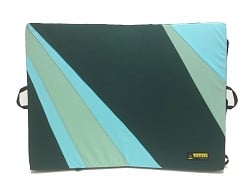

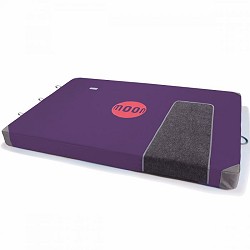

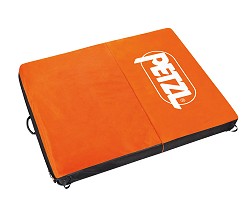
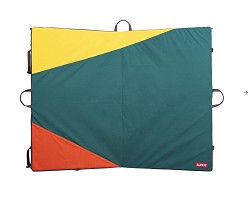
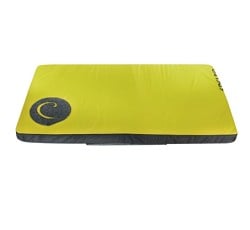
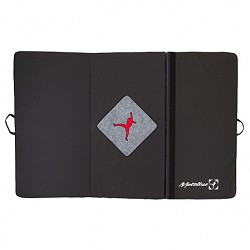



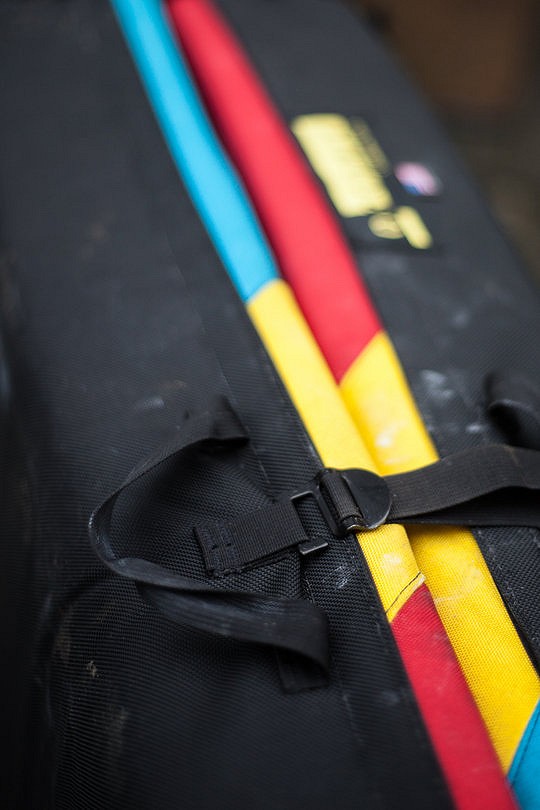
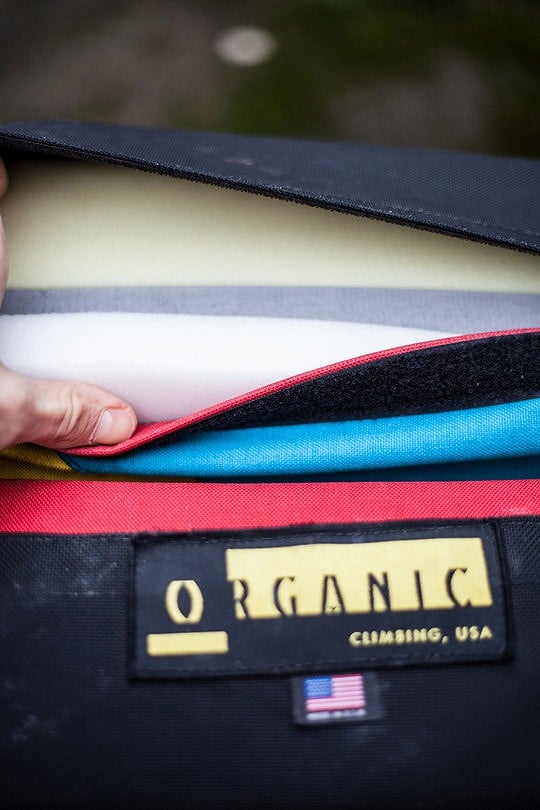
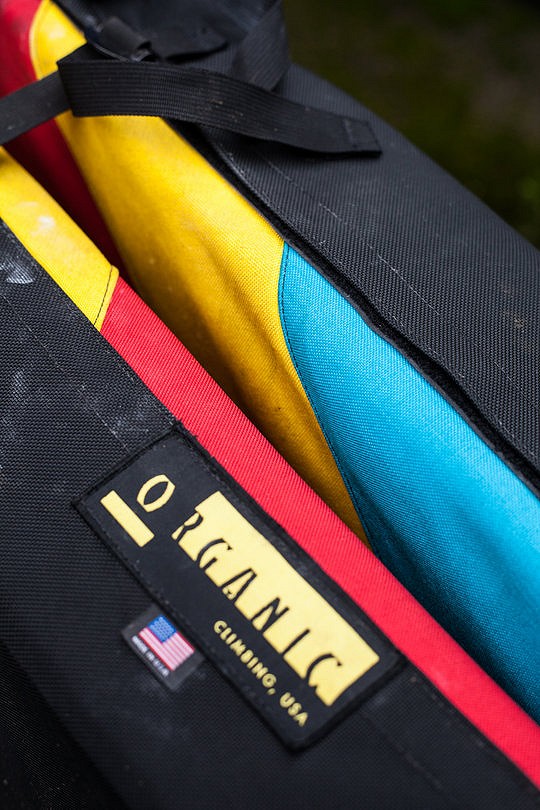






















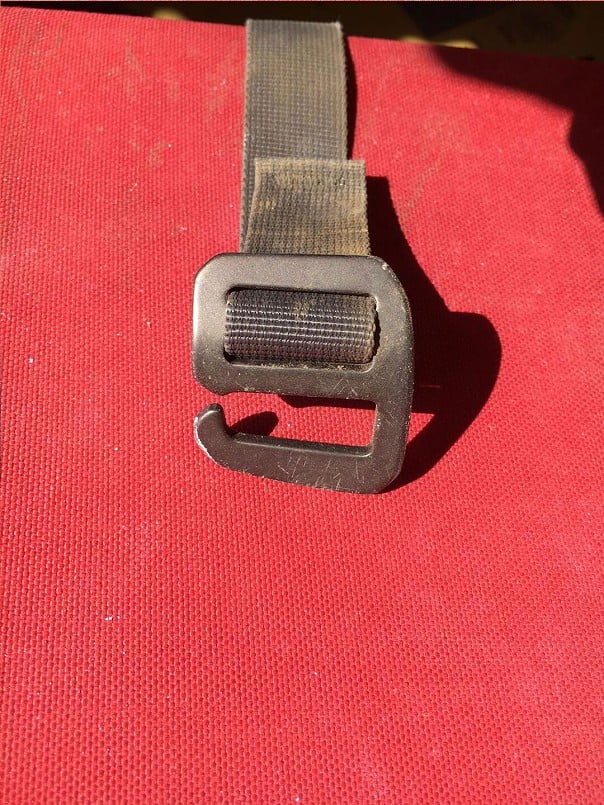
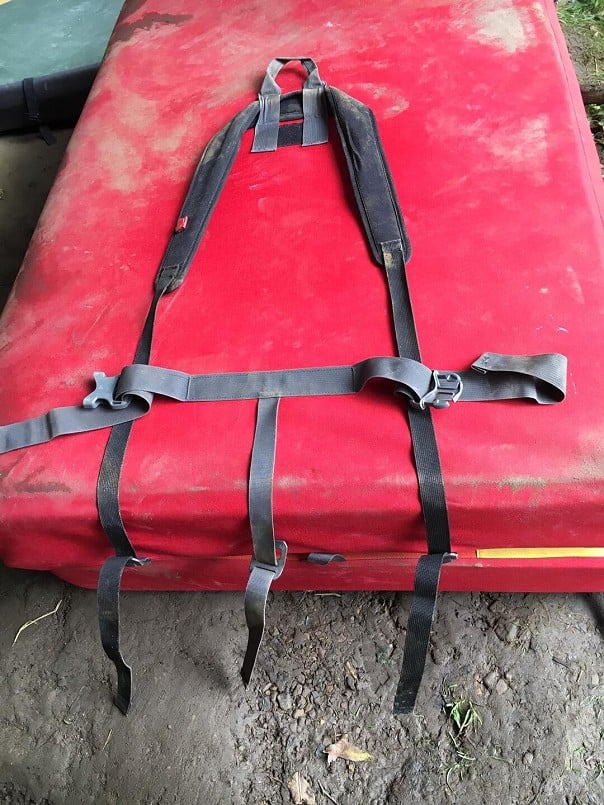
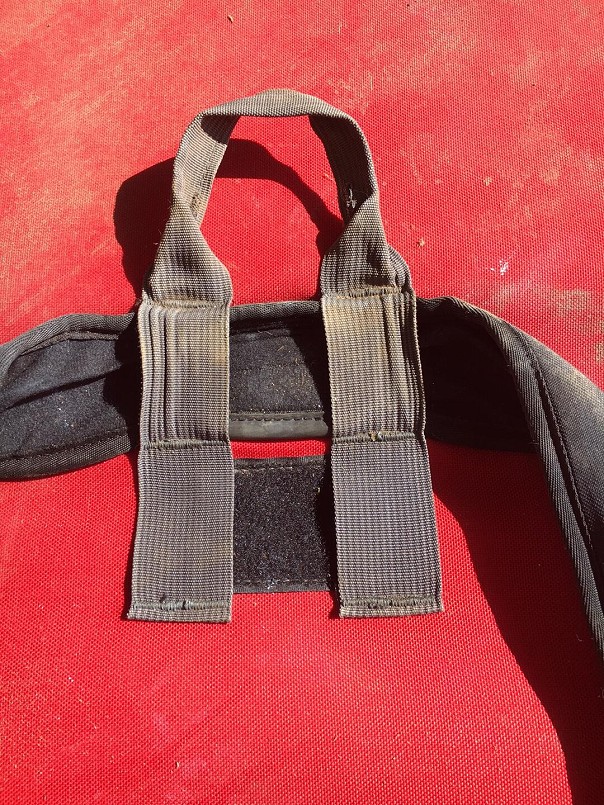


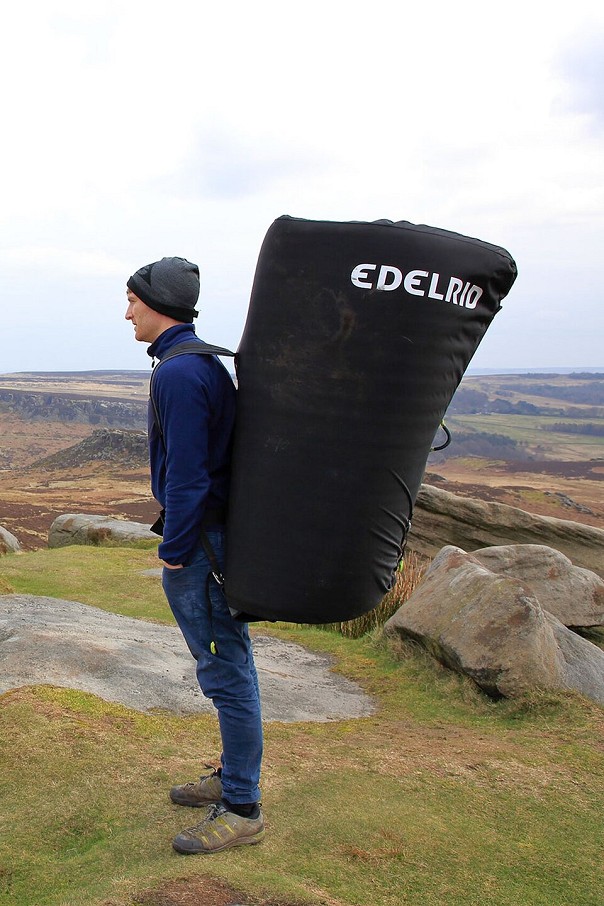
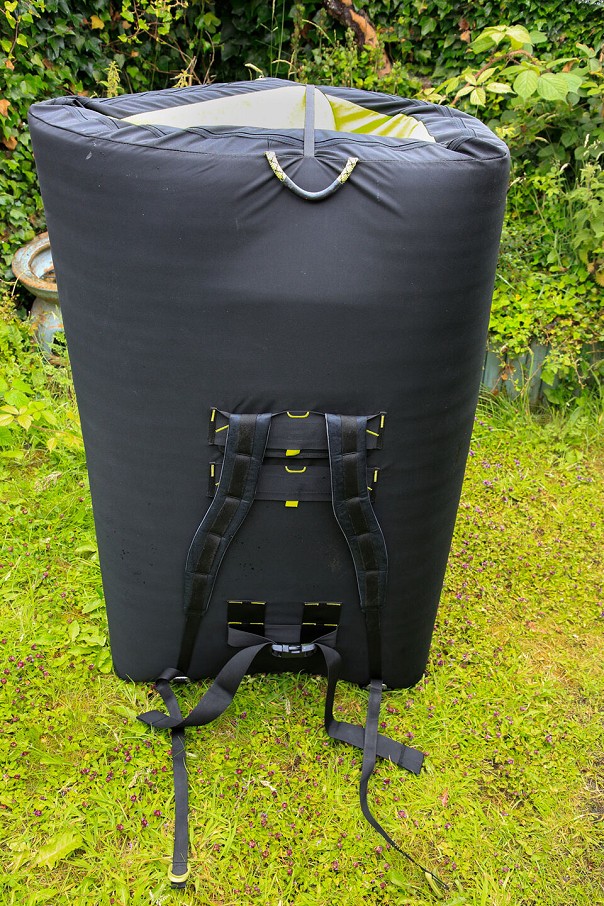
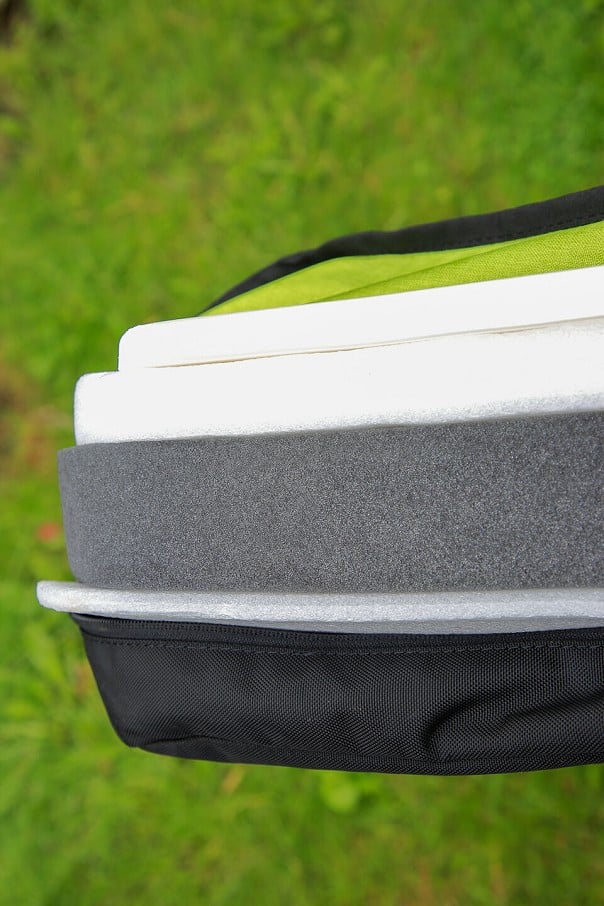



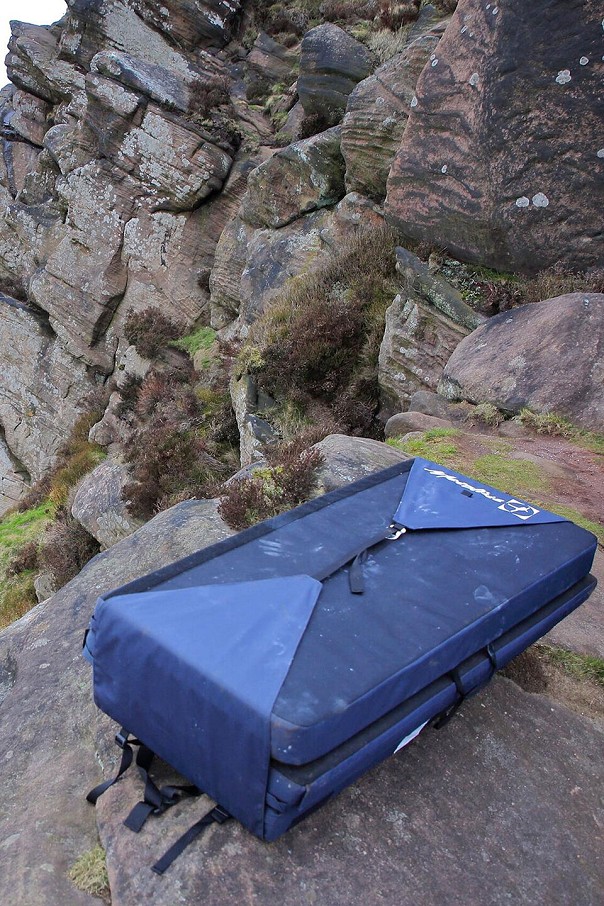
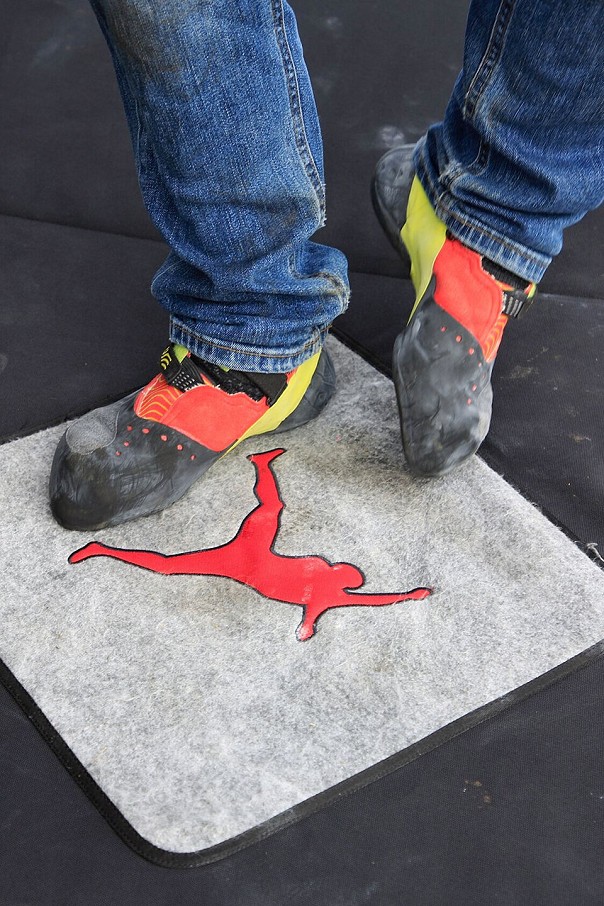
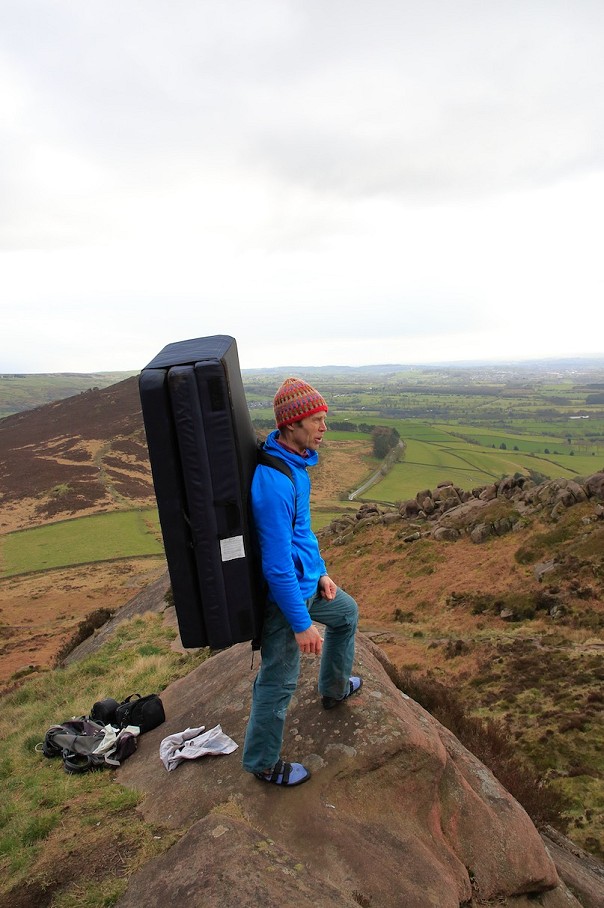


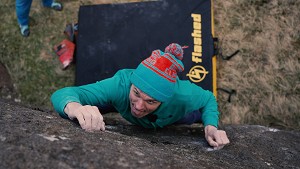

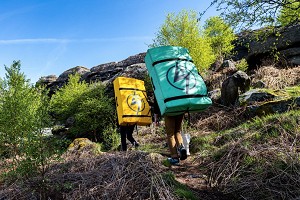






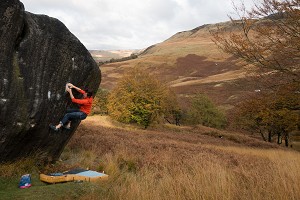
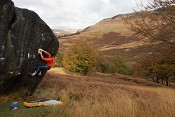
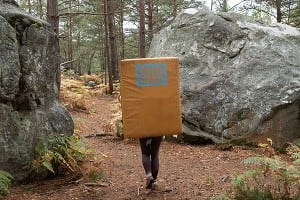

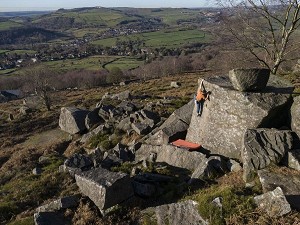

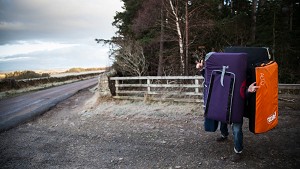




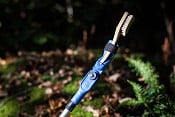
Comments
Great review.
Just to add, anyone who has or is looking to buy an Organic Big Pad - they do an optional hip belt and a thing called a Load Flap.
I have both. The hip belt obviously helps comfort and stability. Shame it doesn’t come with the pad by default.
The Load Flap allows you to strap stuff to the outside of the pad. I use mine almost all of the time to strap extra pads to. It’s amazing what you can carry (like two extra full sized pads) but it’s hard work lifting the whole lot onto your back.
Anyway, I’d recommend getting both items if you do any decent walk ins and want to carry extra pads.
Good shout, not least because despite having owned a Big Pad since 2015 I have never once used either, instead favouring a tenuous series of ratchets (which - in retrospect - probably aren't the best for the pad/foam).
Thanks for the recommendation. Glad you liked the review too!
While I do like the idea of the load-flap. Imho the execution is sub-par. Why on earth no strap below.
Oh, and while lugging more than just the pad, take a good look at the attachment points. The stitches are coming off from my older big pad (the handle on the fold, also the rucksack strap attachment). Need to do some maintenance later this year (glue a bit more fabric on the inside and restitch). Might as well add proper attachment points for the load flap.
I use a couple of this kind of thing to strap 2 pads together - https://www.amazon.co.uk/BlueCosto-Lashing-Strap-Straps-Tensioning/dp/B06XGR9VN6/ref=sr_1_34_sspa - no Amazon endorsement implied! But as per Rob, only for actual walk in. I'm a good citizen and have space to leave them unfurled at home.
Thanks for the review. Very helpful.
I'd really like a big pad but even with an Octavia estate the size in the back puts me off. Does anyone have a Saturn and other (medium size) pads that you put in an Octavia? How many other pads can you get in with the seats down? Currently I can get 3 mediums and a small in the boot with the seats up, but the dimensions of the big pads are far less good a fit for the dimensions of the boot.
Edit: or an Organic Big Pad or a Cirrus.